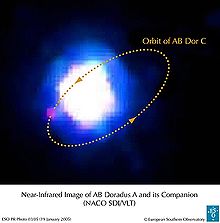AB Doradus
| Observation data Epoch J2000 Equinox J2000 |
|
|---|---|
| Constellation | Dorado |
| Right ascension | 05h 28m 44.828s |
| Declination | −65° 26′ 54.85″ |
| Apparent magnitude (V) | 6.98−7.06/13.0 |
| Characteristics | |
| Spectral type | K1Vp + dM3-4e + M8 |
| U−B color index | +0.37 |
| B−V color index | +0.86±0.02 |
| Variable type | Flare star |
| Astrometry | |
| Radial velocity (Rv) | +28.0 km/s |
| Proper motion (μ) |
RA: 32.14 mas/yr Dec.: 150.97 mas/yr |
| Parallax (π) | 66.92 ± 0.54 mas |
| Distance | 48.7 ± 0.4 ly (14.9 ± 0.1 pc) |
| Absolute magnitude (MV) | 5.86 |
| Orbit | |
| Companion | AB Doradus B |
| Semi-major axis (a) | 135 AU″ |
| Orbit | |
| Companion | AB Doradus C |
| Period (P) | 11.75 yr |
| Semi-major axis (a) | 2.3 AU″ |
| Details | |
| Mass | 0.86 M☉ |
| Radius | 0.96±0.06 R☉ |
| Temperature | 5,250 K |
| Rotation | 0.5148 days |
| Age | 50 Myr |
| Other designations | |
| Database references | |
| SIMBAD | data |
AB Doradus is a pre-main-sequence quadruplestar system in the constellation Dorado. The primary is a flare star that shows periodic increases in activity.
The primary star in this system spins at a rate 50 times that of the Sun, and consequently has a strong magnetic field. It has a greater number of star spots than the Sun. These can cause the luminosity of the star to appear to vary over each orbital cycle. Measurements of the spin rate of this star at its equator have shown that it varies over time due to the effect of this magnetic field.
The system has four components consisting of a pair of binary star systems separated by an angle of about 9″. The binary star AB Doradus Ba/Bb orbits the primary AB Doradus A at an average distance of 135 astronomical units (AUs). AB Doradus C, is a close-in companion that orbits the primary at a distance of 2.3 AU, and has an orbital period of 11.75 years. The latter star is among the lowest-mass stars ever found. At an estimated mass 93 times Jupiter's, it is near the limit of 75–83 Jupiter masses below which it would be classified as a brown dwarf.
This system is a member of the eponymous AB Doradus Moving Group, a loose stellar association of about 30 stars that are all approximately the same age and moving in the same general direction. It is likely that all of these stars formed in the same giant molecular cloud.
...
Wikipedia

